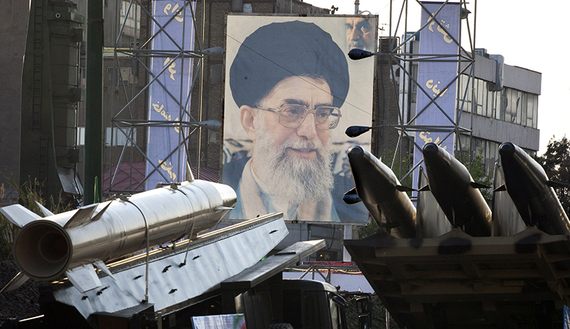Israel Better Be Prepared If Iran Gets Back to Nuke
من مصلحة إسرائيل أن تكون على استعداد في حال عادت إيران إلى النووي
Ilan Jonas/Bloomberg/July 19/18
In September 2012, standing at the podium before the United Nations General Assembly, Prime Minister Benjamin Netanyahu of Israel made one of the forum’s more memorable appearances while holding up a placard showing a cartoon-like bomb.
“At this late hour, there is only one way to peacefully prevent Iran from getting atomic bombs — that’s by placing a clear red line on Iran’s nuclear program,” Netanyahu said. Then he drew a red line on the diagram just under the words “Final Stage.” It’s an image we should bear in mind as the fate of the Iran nuclear deal hangs in the balance. Netanyahu’s UN speech was the peak of his public diplomacy efforts to mobilize the international community to take action against Tehran’s nuclear program. The implicit threat was as clear as the red line he drew: If the world would not act, then Israel would have no choice but to carry out a military strike.
With the signing of the interim nuclear deal between the global powers and Iran the following year, Netanyahu’s threat never materialized. Fast forward to today. With the possible collapse of the nuclear deal in the next few months — the result of President Donald Trump’s decision to withdraw from it — we may well see renewed threats by both Israel and the U.S. to use force against Iran. This is especially true if Tehran decides to resume its production and accumulation of enriched uranium in similar quantities and purity levels to what it produced prior to the deal.
An Israeli strike on Iran’s nuclear facilities remains a remote possibility. The Europeans may yet prove successful in saving the deal. Even if they don’t, the Iranians are unlikely to try and “break out” to the bomb; and even if they do, they are still more than a year away from producing enough fissile material for a single weapon.
But there can be no doubt that Israel is better positioned today to carry out an effective strike against Iran’s nuclear facilities, and to face the certain repercussions, than it was six years ago.
This fact should be weighed in the balance as the international community — and Iran — contemplate their response to the U.S. withdrawal from the pact.
In the early years of this decade, when the military option was being seriously considered by the Israeli government, many doubted its ability to carry out an effective strike that would cause significant damage to the Iranian nuclear program.
Unlike with the Syrian and Iraqi nuclear programs, where a single strike on a single facility was enough to eliminate both countries’ nuclear potential, the Iranian program is comprised of dozens of sites spread across the country — one bigger than France, Germany and Spain combined and located 1,000 miles away from Israel.
Moreover, certain key Iranian facilities are not only protected by advanced air defense systems but are also heavily fortified. For this reason, military analysts assessed that an effective attack would require repeated waves of air strikes, possibly lasting over several days, thus requiring Israeli warplanes to travel back and forth thousands of miles in order to refuel and re-arm. That would be a challenging operation even for a superpower.
What’s more, such strikes would have set off fierce retaliation from Hezbollah, Iran’s proxy in Lebanon, including the firing of thousands of rockets and missiles with a range covering all of Israel. At the time, Israel didn’t have effective defense systems that could address this extensive missile threat. Iron Dome, which is designed to intercept rockets with a range of up to 60 miles, only entered its operational stage in 2011. Development of the David’s Sling defense system, which is designed to intercept missiles with a range of nearly 200 miles — needed for the missiles in Hezbollah’s arsenal that threaten Tel Aviv and various strategic installations and national infrastructure — was then only in its infancy.
Finally, the aftermath of any Israeli strike would have included not only in a long war with Hezbollah but also in strong diplomatic condemnations. Israel would have needed an American diplomatic umbrella to address various hostile initiatives in the U.N. Security Council, as well as urgent military assistance to be able to withstand a prolonged conflict with Hezbollah. It is far from certain that the Barack Obama administration would have provided such protection.
Today, things are very different: Israel is better positioned in every way to carry out such a strike and to deal with its aftermath.
Operationally, the warming of relations between Israel and some countries of the region over the past few years opens a whole range of possibilities to the Israeli Air Force.
Militarily, Israel has made a giant leap forward in recent years in terms of its ability to deliver more bombs, more accurately and to more targets in a given time period. On top of that, last December Israel declared its fleet of U.S.-made F-35 stealth fighters operational. The fleet is still small, just 12 warplanes, but Israel plans to have two full squadrons operational by 2024.
It is true that the Iranians have strengthened their defensive capabilities as well, receiving S-300 batteries from Russia that have been deployed around their most strategic facilities. However, Israel believes that it could overcome those defenses even without the use of its new F-35s, let alone with them.
In addition, the Trump administration — unlike the Obama White House — is likely to agree to provide Israel with “bunker-buster” bombs that would be essential to destroying key elements of the Iranian nuclear program, specifically the Fordow enrichment facility, which is buried in a mountain tens of meters underground.
Israel is also better positioned today to address the aftermath of such an attack. First, it’s certain that the Trump administration would provide full protection in the Security Council, while also delivering as much materiel as necessary to sustain a long Israeli military campaign.
Second, while Israel could face significant damage as a result of heavy barrages of Hezbollah’s ever-increasing supply of missiles, the proven capabilities and wide deployment of Iron Dome batteries, along with the David’s Sling system being operational, make Israel’s preparedness significantly higher than it was a few years ago.






















